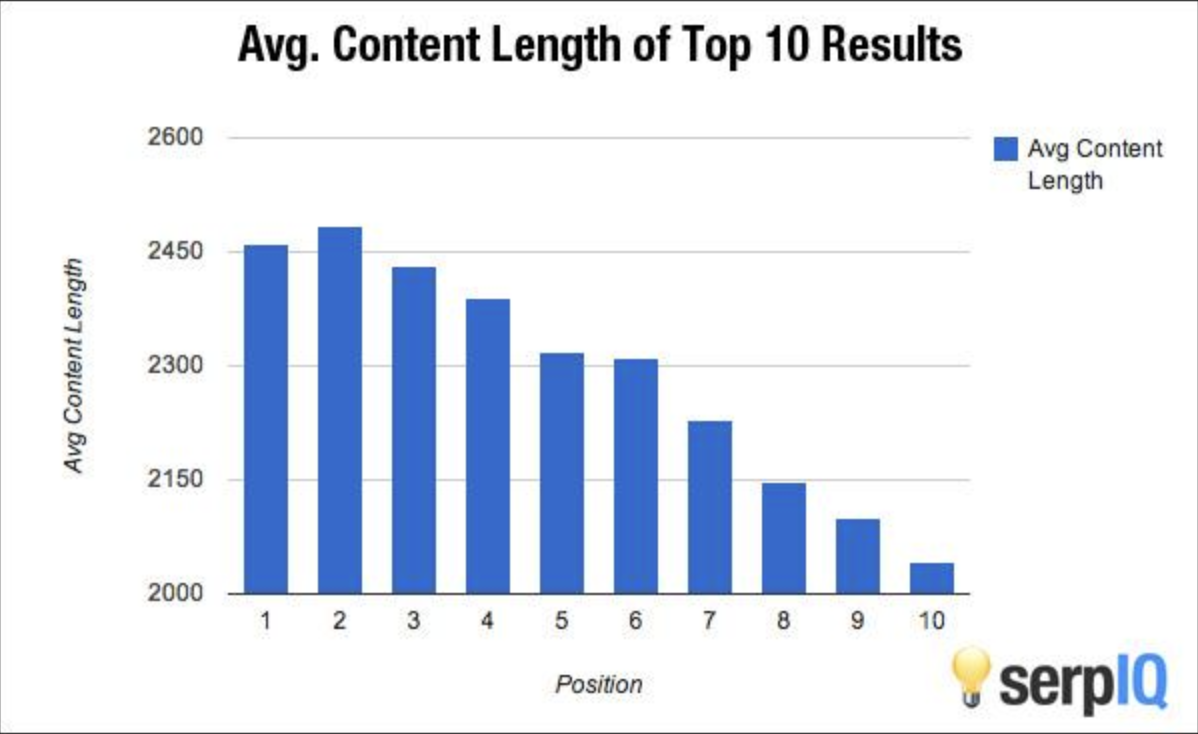Creating powerful content that ranks well is definitely one of the most popular platforms for any online business looking to increase its brand awareness, traffic and revenue. But what type of content should you be creating and how do you create it?
In this post, we’re going to cover long form content marketing, link building and why combining both can be beneficial to your content strategy. This goes beyond how to gather content, and gives you the specific steps to develop a holistic strategy and generate amazing content and backlinks.
In this article, we’ll look at:
-
- What is long form content and why is it important for you?
- What is link building and why is it important for your website?
- How long form content and link building work together
- Detailed procedures so you can implement these strategies on your website
By the end of this post, you’ll have the in-depth knowledge and all the tools necessary to do it yourself!
What is Long Form Content?
Depends on who you ask. Some content marketers will say 700-1,000 words is considered long form while others believe you need to go well above the 2,000 word mark. The truth is, there really is no universal word count for this type of content in the digital space. Instead, it varies depending on your niche, target audience, and competitors. That being said, long form content is best defined as high quality content with a high enough word count in comparison to competitors ranking for a specific keyword.
Also Read: How To Get The Best Click-Through Rate
Why Does Content Length Matter?
Before we get into the nitty gritty, let’s quickly go over why both long and short form content are important to your branding strategy. When we think of powerful content, we associate it with content that is concise, gets to the point, and provides value. For most, this type of content fits the needs of a digital brand. However, long form content marketing has become popular among content writers due to its ability to outrank competitors.
We’ve all come across it before. You’re searching for an answer to a specific strategy or procedure in your niche, and find an article the size of a small novel. While a potential customer or reader might be annoyed by the infinite scrolling, this meatier content is intended to be highly useful.
The point of writing a long form piece of content is to cover absolutely everything within that topic; this provides the reader with an in-depth understanding rather than a brief overview. For instance, if you’re a B2B business looking for a new outbound email strategy to implement, you might search for “best B2B lead generation strategy”.
You’ll come across a number of articles that cover various strategies on this topic. You might find one that looks at how to increase sales, another that covers how to create email content and follow-ups, another that focuses on effective landing pages, or one that reviews different CRM tools. But wouldn’t it be easier if you could find one that covered everything?
That’s what long form content does. It provides your target audience with an end-all be-all article within your niche and topic, not requiring them to go anywhere else for the answers. Not only is it useful for digital branding, but with long form, content creators are able to include more keywords, higher quality content, more backlinks, more affiliate links (if applicable), and achieve overall better content production.
Why Long Form Content is an Important Digital Marketing Tool
Everyone is skeptical of it at first, but it works, and here’s why.
Although long form content has started to increase in the digital space, many brands still stay away from it. Because of this, it can be rare to find this type of content in your niche. This is also the same reason it can be a great asset for your brand identity.
If the competition in your niche is difficult to rank for, long form content that covers a variety of topics is likely to outrank competitors, even against higher DR sites. Why? From a customer experience, this type of post provides a one-stop shop, incentivizing visitors to stay on your page longer and removes the need for them to search anywhere else.
We all know the best platform to get more online traffic to your business: SEO and keyword optimization. That part is easy. But getting traffic isn’t enough. To have a successful online business, you need to focus on all the branding efforts that come after getting traffic: return traffic, direct traffic, brand searches, engagement metrics, conversions and clicks, etc.
Long form content helps solve these issues by creating more in-depth content that provides a ton of value to your audience. Data has shown that longer content resonates better with customers. Medium compiled analytics on its most successful articles by measuring the average time on page in relation to length of a post and the amount of time it takes the average reader to finish the post. Data showed that their most successful blog posts were taking readers about 7 minutes to read, or around 1,600 – 2,000 words long.
Let’s take a deeper look at why this is an important tool for digital branding.
Long form content ranks better
This is probably the biggest benefit of long form content because although every content creator is trying to increase authority and gather content that is valuable, ranking higher is the first and most important step. Despite the critics, there’s plenty of evidence showing a direct correlation between word count and rankings.
SerpIQ released data showing that SERPs are dominated by content longer than 2,000 words.
 Another study by Backlinko and Clickstream found similar results showing that longer content leads to better overall rankings.
Another study by Backlinko and Clickstream found similar results showing that longer content leads to better overall rankings.
The reason for this dates back to 2012 when Google released a new algorithm update, which affected nearly 12% of search results, penalizing sites with “thin” content.
Longer content is more authoritative
When you gather content, no matter what niche or topic you focus on, you want to make sure you’re providing value to your readers. Let’s say you wanted to learn how to create an app from start to finish. Would you trust a 50-page manual or a short blog post on the topic? My guess would be the former.
Longer and more in-depth content production has a direct correlation with search engine rankings. Google prefers informative posts for certain topics and ranks them higher depending on the keyword.
More ability to create evergreen content
Long form content is much better at staying relevant for a longer period of time. Short posts are intended for a quick overview and generally become irrelevant faster. That’s why top sites consistently gather new content … to stay up-to-date.
Long form content can take a little longer to get to the ranking you want, but from a marketing perspective is much better because it will then stay there for much longer (we’re talking 3-5 years). Even if the content that’s in a post becomes outdated, changing or updating it is usually simple. And because there’s such a large amount of it in longer content, small changes are less likely to have large effects on rankings.
Long form content gets more links
This might be stating the obvious, but longer content has more opportunities for link building, allowing it to acquire more backlinks over a longer period of time. This is actually a very important part of creating the content and crucial to digital branding, which we’ll get into later in this post.
Studies also show that for legacy publishers, longer content leads to more shares. The most shared articles in the New York Times, for example, had on average 2,000+ words.
Easier to promote and share
While social media platforms, like Facebook, LinkedIn and Twitter are a good way to reach an audience, if you don’t have a solid marketing strategy or campaign to promote, they’re not going to be helpful. Short blog posts are great too, but they don’t lead to high retention or conversion rates, especially on social media.
Long form guides give you an opportunity to create a marketing campaign and share the results of your work. Sharing longer articles on social media will also lead to much higher engagement (likes, shares, retweets, etc).
It also gives you a great excuse to reach out to contacts on your email list or social media channels. Customers are always looking for free value, no matter the length of the content. It’s both a way to promote yourself and get feedback on your content.
Now that we’ve examined long form content, let’s take a look at the other important piece of the puzzle: link building.
Also Read: Top 20 Content Marketing Podcasts
What is Link Building?
Link building can be intimidating to many, but the concept is simple: acquiring links from other websites to your own.
What’s the point of it? Search engines, like Google, use links to gather content from the web. They do this in two ways: crawling links between individual pages on a site and crawling links between entire sites. Link building is an important step in digital branding, as it helps increase the overall traffic and authority of your site.
There are a number of strategies out there for link building successfully and many brands consider it one of the hardest parts of creating good SEO content. That being said, let’s jump into why it’s important for SEO.
Why is Link Building Important?
While long form content is a good strategy to implement with your content, link building is fundamental to increasing SERPs and ranking well. Search engines use links to discover new web pages and determine how well a page should rank. To do this, Google will look at the number of links pointing to a page from external sites and the quality of those sites.
That being said, the goal for a website or content creator is to acquire as many high quality links as possible in a post. The difference between a good link and a bad one depends on whether it is labelled as dofollow or nofollow. Simply put dofollow links are crawled by search engines and nofollow ones are not. To learn more about dofollow links, check out this post by AuthorityWebsiteIncome.
Without good backlinks, your content or site won’t rank well, no matter how good your SEO strategy is. Simple as that.
Building relationships and personal branding
While there are variations of link building strategies, all link building involves outreach to other relevant sites and blogs in a niche or industry. Generally content creators will reach out asking to promote their own content, or a specific piece of information within that content (we’ll get into different backlinking strategies later on).
The main goal is to acquire a link, but this type of outreach can help build long-term relationships, increase personal branding, and build your email list. Building relationships with others in your niche is important for digital branding.
Expanding your audience
A strong link from a high authority site will not only increase SERPs, but also send more referral traffic to your post. Assuming that your backlinks are coming from relevant sources within your niche, then the traffic being sent to your site is most likely from new customers.
The value of a link goes well beyond the SEO benefits – it’s also a pipeline for expanding your audience. Find strong links from good websites and build a relationship with the site owner or content creators in your industry – it will benefit you in a number of ways.
Digital branding
This one might seem obvious and more of a passive objective, but still an important one to mention. Good link building will help build your brand and establish you as an authority in your niche. For instance, creating a piece of content based on industry data will increase your chances of becoming more recognized in a specific niche. Doing outreach on top of this will illustrate your expertise and get other experts in the industry to help spread the word.
How Can Long Form Content Act as an Asset to Link Building
Longer content and link building are a deadly combination for digital branding. Both have proven to be effective at increasing SERPs and should not only be used together, but compliment each other.
Most link building techniques, such as the Skyscraper technique, work better when a post has more content to work with. For instance, Skyscraper link building, in simple terms, tells us to a) find link-worthy content in your niche or industry, b) create a piece of content that’s better, and c) reach out to the right brands to link back to your site.
This technique has a greater chance of success when you gather content with more meat to it. Why? The longer your content, the more research and statistics you’re going to have in it. Thus, increasing your opportunity to create better pieces of content and information.
A study by Backlinko analyzed 912 million blog posts and showed that long form content gets more backlinks and social media shares. In fact, content longer than 3,000 words gets an average of 77.2% more referring domain links than content shorter than 1,000 words.
Now that we understand why long form and link building are so important to digital branding, let’s take a deeper dive into creating your own content and strategies for link building.
Creating a Content Brief
Before you begin to create and gather content, you need to know what you’re writing about. Every good piece of content has thorough research behind it. It’s important to have a content brief because it allows you to analyze your competitors, research optimal keywords, create a list of potential link building opportunities, and develop a structured outline for your content. Let’s take a look at how to create a proper brief.
Step 1: Find your competitors
If you already know what topic you want to cover in your content, then you’ll want to find competitors that are ranking for that keyword. However, if you’re looking for ideas on what to write, finding your direct competitors is a great way to analyze your niche and find keywords.
First thing you’ll want to do is create a spreadsheet (we recommend Google Sheets), with a tab labelled “Competitors”. There are a few ways to search, however we recommend using AHrefs, as it will give you a number of important analytics in addition to your competitors URL (SEMrush works too).
The key thing we need to do is find out what is working well for sites in your domain ranking (DR). For instance, if a site has a low DR, you may find they still get a good amount of traffic by targeting easy keywords. This is what we’re looking for – sites with competitive or low authority that are ranking for low difficulty keywords.
You can find your competitors by searching your site URL in Ahrefs, clicking on organic search, and looking at the top 10 competitors. Check them out and record their DR, along with any other information you may find useful. To find more competitors, you can do this for each page on your site, as well as finding competitors for your competitors. This should give you enough sites to work with. This strategy also works with SEMrush.
If you don’t have access to AHrefs or SEMrush, there are a couple other ways to find competitors. Alternatively, you can use SimilarWeb to get free results. Simply type in your URL and follow the same process above.
Google also allows you to search for competitors in your niche by searching “related:” into Google then typing in your URL. It may not be as effective or thorough as AHrefs and SEMrush, but should give you similar results. Record as many competitors as possible in Google docs and move on to the next step.
Finding keywords
If you’re really looking to set yourself apart from the average online marketer, you’re going to need to go beyond a simple [Your Niche] search. The real value comes from finding those words that only true experts would know.
Another handy thing about keeping this list is that you can start greying out keywords you’ve already covered. This is particularly useful if you are planning on coming back to this at regular intervals throughout the year.
 How do we find these keywords? The answer is actually pretty simple: Google
How do we find these keywords? The answer is actually pretty simple: Google
If you do a simple search of “[Niche] Lexicon” or “[Niche] Jargon”, you’ll be presented with tons of different terms which you’ve probably never heard of before.
As you build out your list of terms, you can then start to categorize them into different sections which will help you build out your list.
Keep going as much as you can here. The more keywords, the more content you can queue up and the better your long term results will be.
Analyzing keywords
This part is a lot more tedious and will require AHrefs or SEMrush to perform.
There are 5 key things to look at when analyzing and choosing keywords for your content:
- Low keyword difficulty
- Good to high search volume on that keyword
- High click percentage of the keyword
- Low quality content of competitors
- Low DR competitors
It is important to note that you may not always find competitors with a low DR, which is fine. You do however want to find ones that you can at least compete with, so be sure to keep in mind what your competitors DR is in comparison to your site. Keep this in mind as you do your keyword research.
The overall strategy for finding a good keyword is to use the competitor sites to find keywords they are ranking for, which of those keywords are ranking well, and have low to medium keyword difficulty.
To do this, go to Ahrefs, type in the competitor URL into Site Explorer, go to the top pages tab on the left, and look at the top rated pages on the site. Find the articles that are ranking well and see what their keywords are. Click directly on the keyword in AHrefs and see what the keyword difficulty of that word is and the organic search volume.
Again, keep in mind the five points made earlier to find the most optimal keywords.
If you use a different keyword research tool, then you can still follow the general procedure of this strategy and translate the process over to that tool. If you aren’t using a tool, it will be a bit more tedious.
While you’re looking at keywords, also check the contents of the article/post/pages that are ranking for that keyword. If they are ranking well, but the content is poor quality (short, poor grammar, outdated, etc), you’ll most likely be able to outrank your competitors.
For example, you find a keyword with multiple articles on multiple competitor sites that has good traffic and a low to medium keyword difficulty, but after looking through all the articles ranking for that keyword, you notice that every article is very short and written poorly. That is a good indication that you will be able to easily rank for that keyword. You can do this for multiple keywords if the competition is weak.
If the DR of competitor sites is low, that’s another indication that you’ll be able to outrank them. For instance, you find a low difficulty KW, high percentage of clicks on search engines, good search volume, and the top 10 sites all have low DR (or low in comparison to your site). This would be a good indication that the keyword will be easy to rank for.
The strategy here is by finding low DR sites with low quality content that are ranking for low difficulty keywords, you’ll be able to write a better article, which other domains will want to refer to instead.
When you’ve found a keyword or multiple keywords that fit the formula, go back through the top ranking articles and find their referring domains. In a separate sheet, copy and paste all of the referring domains – this will be the list we will use for backlinking.
When going back through the articles, also look for any useful statistics, unique information, videos, media, images, charts, product links, etc. Examine them and answer the following questions:
- Is the information in the article or content outdated? For example, do they have an infographic or image with outdated statistics?
- If the content is a review or round-up post, are they promoting a product or have affiliate links linking to a product?
- Do they provide any PDFs or downloadable media and if so, how good is the quality of that media? Can we recreate the content to look better? Is it outdated? Can we find more up-to-date information?
- Are they linking to any broken or expired links?
These are all important to make note of for your link building strategy, which we’ll discuss next.
Also Read: Is it Possible to be Guaranteed Google First Page?
Link Building Strategies
We’ve already discussed what link building is and why it’s important to your long form content. Now let’s take a look at the different strategies.
Broken link building
What is broken link building? Broken link building is a tactic whereby you find a broken or dead link, recreate the dead account, then tell anyone linking to the dead resource to instead link to your recreated content. It works because nobody wants website content linking to dead links.
There are a number of ways to do this. We’ll go over some of them below.
Procedure 1
Step 1:
Find the top 50-100 (or more) competitors for your keyword and record their information into your Google docs (URL, DR, keyword, search ranking, traffic, referring domains, and any other important information). A quick search in the AHRef’s Content Explorer is an easy way to do this.
Step 2:
Once you have your list, input the first URL into Site Explorer. Then go to Pages > Best by Links > filter for HTTP 404 errors. This will give you a list of linked-to pages that no longer exist on that post.
Alternative option: visit each site and manually find which links (if any) are not working.
Note: if the post does not have any dead links, then move on to the next competitor post.
Step 3:
Copying and pasting the dead link URL into Wayback Machine will show the original page. Take a look through the contents of the page in order to understand what the content was about.
Step 4:
Input the dead link into Site Explorer and see who else is linking to it. Export this list.
Step 5:
Create the new piece of content based on the broken links content. Make sure to include updated stats/content so it’s relevant. Publish the content.
Step 6:
Generate a list of emails for each of the sites that are linking to the broken link using tools like AnyMailFinder and Hunter. Reach out to them via email, kindly let them know they are linking to a broken link, and ask them to link to your new piece of content.
Step 7:
Repeat this with as many competitors as you want to gather a giant list of broken links, which you can recreate content for and ask to link to.
Procedure 2
Step 1:
Find resource pages in Google by using the following terms:
KEYWORD intitle:”resources”
KEYWORD inurl:”links”
KEYWORD intitle:”links” inurl:”/links”
KEYWORD blogs inurl”resources” intitle:”resources”
Step 2:
Scrape all of the Google search results using either Scrapebox or SERP scraping bookmarklet for Chrome.
Step 3:
Export the outbound links from all those pages. You can use Screaming Frog or Scrapebox for this. Both of these will check the HTTP status for every outbound link, so you can identify the 404 errors.
You can also extract all external links on a page using Google Sheets with this formula:
=IMPORTXML (“page url”,”//a[not(contains(@href,’domain’))]/@href”)
Then use a tool like LinkMiner to check the HTTP status of all external links one by one.
Step 4:
Once you have your list of 404 errors, copy and paste them into Ahrefs Batch Analysis tool to identify the best broken link building opportunities. Find a link that is relevant and has a lot of referring domains.
Step 5:
Replicate or replace the content, reach out to all the sites linking to the broken resource, and suggest your link as a replacement.
Purgatory link building
What is purgatory link building?
- Find expiring/auction domains with links to relevant content/information to your keyword
- Create an improved version of the linking pages (similar to broken link building)
- Reach out to anyone who was linking to the expiring link and ask to link to you instead
How is this different from broken link building? The strategy with broken link building is to find a resource that sites are linking to which no longer exists. Purgatory link building is about finding expiring links. The main difference is in timing and scale.
When you reach out to domains with expiring links, it might be the first time they’ve noticed that the link is about to expire. Many times the link will be a landing page or never show up as broken. This strategy is also better to scale for smaller resources, resulting in more opportunities at a quicker pace.
Step by Step Purgatory Link Building Process
Part 1 – Find Expired Domain:
In this step you are going to find a domain that has others linking to it, they may not yet know that the link on their site is useless since the domain is in “purgatory” (not yet expired but the page is no longer live).
We will identify a domain, the optimal page on that domain, and the type of asset to create to then reach out to.
Step 1:
In this stage we want to identify domains that have solid and real links. The best way to do this is to filter on TrustFlow from Majestic and verify it has at least a little traffic. This shows it has quality links and likely not terribly abused from an SEO standpoint since it ranks in Google.
- Go to SpamZilla
- Enter into the search term
- TF > 15
- Keywords > 1
- Pick the Topical Trust Flow Category if you want to ONLY look in your niche
One other filter to apply is to select “MarketPlace Domains” and then only select GoDaddy Auction. You will be using this filter a lot so be sure to save it!
Step 2:
Open up each of the domains that look like they might make sense for you. Here you’re looking for a site that has real and relevant links to the URL. To help show what site would make a good target, examine both the referring domains and pages that links have been built to.

You are looking for real links to a decent resource.
Step 3:
In the pages tab we are looking for a page that received several links and had a high Trust Flow, and that we’re able to recreate.
Step 4:
The next step is to check to see if we can recreate content that is superior to the expiring content.
If we were to execute this example we would need to re-write and add some additional value that would have marketers taking the time to link to it.
Step 5:
Check the link in Archive.org to see that the page can be recreated.
Note Archive.org and TheWaybackMachine are often down or not working and here are some alternatives.
Step 6:
This step is about planning for your link building outreach.
Using MajesticSEO and Ahrefs, build a complete list of everyone who links to that page.
MajesticSEO:
- Enter the URL in Site Explorer
- Go to Backlinks
- Export Data
Ahrefs:
- Enter URL
- Select Backlinks
- Export Data
Part 2 – Create a Link Worthy Piece of Content
Creating “just” an article may not be enough. The goal isn’t to just match the quality of the content, but to top it.
Article:
Certainly matching the article quality is important. Doing a little bonus keyword research at this stage so that the article is being created to both be a suitable link alternative but then have a reasonable shot at ranking for a keyword that matters.
The link juice makes this strategy often worth it on its own but if you can find an angle that will move the needle for traffic, that is even better!
Infographic:
If you can get a decent infographic created in a matter of hours for $5 (via Fiverr) with the research already done (share the archive.org link for the data) then it is a great means of getting some additional link love!
Video:
If there is a simple video that can be created that will also fulfill the searchers query that might be enough to reach out and share.
Tool/Aid:
If the opportunity is large enough there could be a simple template or tool that would make the effort to swap out the link worthwhile.
Publish the content and be ready for the next step.
Part 3 – Outreach
For this relatively efficient outreach system focused around link building the outreach tool from SEMRush fits the bill:
- Upload list
- Create template
- Start sending
- Monitor and follow up if needed
You can also do manual outreach or use other tools like Mailshake.
Industry roundup link building
What is an industry roundup? Industry roundups are done by website owners who put together a weekly and/or monthly round up of the best content out there in their niche. The purpose of a roundup is to give their audience a post with a number of links to posts, articles, sites in their niche.
Getting your post/article listed in roundups will lead to more traffic to your post. This is similar to link building but more direct.
Step 1:
Create a Google spreadsheet with columns labelled: Website URL, Contact Name, Contact Email, Status, Notes
Step 2:
Search for industry roundups in your niche. You can do this by searching the following text:
- Keyword + link roundup
- Keyword + weekly roundup
- Keyword + weekly link
- Keyword “inurl:”roundup”
- Keyword “intitle:”roundup”
- Keyword + best posts of the week
- Keyword + best blogs of the week
Use a variation of these to find the best roundups in your industry/niche. NOTE: when searching for roundups, make sure you find ones that are active and consistently posted. Check to see when they’re last post was.
Step 3:
Once you’ve found one, record their information in the spreadsheet. NOTE: this can be passed to a VA to research and fill out.
Step 4:
Find the contact info and reach out to the site owner or manager, asking them if they would be interested in posting your article/post in their next roundup. Do this for any relevant roundups you find.
Skyscraper link building
What is Skyscraper link building? Finding a single source of outdated data with multiple sources, data, or statistics in it, that multiple competitors in a niche are referencing, then creating a similar source (in the form of a PDF, deck, presentation, etc) with updated information, and having others link to you instead.
There are a couple of strategies to this, which we’ll discuss below.
Option 1:
Step 1:
Go to Ahrefs Content Explorer and enter your keyword. Research the top sites and find outdated facts that one of the articles is linking. You’re looking for files such as a PDF, presentation, deck, images, etc. that an article is linking to which is outdated.
Step 2:
Once you’ve found the outdated data point, copy/paste that link into Site Explorer. You’ll be able to find all the articles/posts linking to this data point. Export the sites that are linking to the outdated link.
Step 3:
Build your own version of the outdated data points, but update all of them. Example: if the original link was to a presentation of B2B lead generation tactics from 2009, you then create a presentation on B2B lead generation tactics for 2020.
Step 4:
Find the emails/contact info for each site linking to the outdated statistics (or go into SEMrush and find the sites and emails)
Step 5:
Reach out to each article, let them know they are linking to an outdated link, and ask them to replace it with your updated data points. Each outreach email should be unique and geared directly towards the person you’re emailing. No generic templates.
Option 2:
Step 1:
Go to google, search the keyword (or a variation of the keywords) and include “deck”, “powerpoint”, “slideshare”, “PDF” or any other relevant words. Search for a link that contains a presentation, deck, etc of data points for the keyword you’re focusing on. Find something that is outdated. Use search terms intitle:” “ and inurl:” “
-
- Ex. Keyword: B2B lead generation
- Search: B2B lead generation intitle:”tactics”
- Search through results and find a slideshare of outdated data points on B2B lead gen tactics
Step 2:
Once you’ve found the outdated data point, copy/paste that link into Site Explorer. You’ll be able to find all the articles/posts linking to this data point. If you are unable to find a list of high quality sites/posts linking to this data point, then go back to step 1 and find another outdated piece of content.
Step 3:
Export the sites that are linking to the outdated link.
Follow steps 3-5 from Option 1 above.
Also Read: 5 Steps to Increase Your SEO Traffic Generation This Month
How Content Refined Can Help
The combination of long form content and link building, executed properly can be a lethal SEO weapon. It’s long-lasting, more likely to increase rankings and traffic, and provides a greater platform for links and growth.
But it’s easier said than done. The difference between understanding a procedure and executing it within your business can be the difference between success and failure. Not every business has the time or resources to generate long form content on a consistent basis. Don’t worry – that’s where Content Surge comes in.
Content Surge takes all the strategies discussed above and creates a monster article based on your niche that will outrank all your competitors.
Who is Content Surge for?
Content Surge was created for any brand with an online presence that’s looking for an edge with consumers, wanting to increase their search rankings, or are new to SEO and want to increase their digital brand.
A lot of brands are intimidated by SEO because of how difficult it’s become to compete. Many businesses don’t want to test out a new marketing strategy in case it negatively affects their consumers.
However, you don’t need much to get started with us. If you have a website, know your target audience and consumers, and want to increase your rankings but aren’t sure how, Content Surge will create the content and link building that’s right for your brand.
How does Content Surge work?
Strategy Session:
As we’ve discussed, content creation as a tool for digital branding works wonders, but simply creating the content and pressing publish doesn’t always get you the results your business needs.
With Content Surge, our experts use an advanced digital marketing strategy combining keyword research and link building opportunity identification to identify the best piece of content for our client and their business!
During the initial strategy session, we go over what your brands needs are, assessing your niche, and what type of goals you’re focusing on in order to be able to create the best strategy for your brand.
Content Creation:
Content Refined produces the best articles in the world for the identified opportunity. This can go beyond words to include video or infographic etc. Content Surge pushes the science of digital marketing to the next level by using advanced tools like SurferSEO, MarketMuse, Grammarly and much more to produce the best article in the world for the given topic with a high probability of ranking well.
White Hat Link Building:
“Just Create Great Content” is sound advice but not an optimal strategy for brands who want to get serious about building profitable website content. With Content Surge the link building strategy is built into the content itself and then executed by our team.
The strategy identified and then the content created around the strategy could be popular strategies like the SkyScraper, Broken Link Building technique or it could be some internal link building strategies like the Purgatory Link Building Strategy.
Whatever the strategy may be, each one is created individually and uniquely to conform to your needs. This isn’t your generic cookie-cutter content strategy!
Also Read: Top 6 Digital Marketing Blogs You Should Follow in 2020
What results can you expect with Content Surge?
As a client, Content Surge will give you a competitive edge and unfair advantage in your niche. Our advanced tools and expert team give you the best solution to your content strategy in order to increase your rankings and traffic.
You can expect:
- Increased traffic to your site
- Higher search rankings for specific keywords
- Increase in referring domains to your site
- A monster piece of evergreen content








